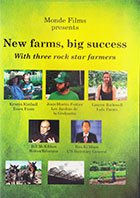
New Farms, Big Success 2014
Distributed by Green Planet Films, PO Box 247, Corte Madera, CA 94976-0247; 415-377-5471
Produced by Monde Films
Directed by Jocelyn Demers
DVD , color, 53 min.
Middle School - General Adult
Agriculture, Business, Ecological Living, Economics, Environmentalism
Date Entered: 09/01/2015
Reviewed by Michael J. Coffta, Business Librarian, Bloomsburg University of PennsylvaniaThis documentary examines three innovative farms that have designed and implemented environmentally and financially sound strategies for long-term business. Prefacing their work with terse accounts of the threat of global warming and fossil fuel-related pollution, the makers of this fascinating work offer alternative models for agriculture on a variety of scales and in a variety of settings. That is, the film examines farms both large and small in rural and even urban settings. Each farm takes a slightly different approach to sustainable farming, but all bring to light effective practices for large, sprawling farms, small farms, and even residential gardens.
The dynamic practices of the 500-acre Essex farm in upstate New York State, were exposited the book The Dirty Life. Drawing from the principles of this book, the author/farmers expand upon issues including sustainable farming, debt management, solar arrays, and the minimization of consumption of fossil fuels. The farmers demonstrate how simple practices and principles, such as capitalizing upon the interdependence of animals and crops, have profitable and environmentally sound outcomes. At another farm in Quebec, totaling only 2 acres, the viewer is quickly staggered by the maximal use of this land and the abundance it may produce with proper planning, resource management, and ecologically considerate techniques. Last, the film examines the urban greenhouse, Lufa Farms, on a rooftop in Montreal. Here, the duteous planning and execution of the farm’s sustainable model, including obvious concerns such as water leaks, are demonstrated.
Stylistically, the film makes interesting use of pen and ink drawings throughout- illustrating root systems and insect life. These drawings, intermingled with footage, subtly reinforce the theme of simplicity. In addition to extensive interviews, the film actually shows the farmers performing the tasks, such as moving chicken pens and weeding, rather than just describing or listing these them. While the amount of labor may turn off some viewers, it is an authentic representation of what is involved, and gives the film a sense of transparency and honesty.
The most distinct feature of this film is its near-constant reminders of the profitability of these environmentally friendly models. While some may dismiss the notion that eco-conscious farming can be lucrative, the film does not shy away from providing exact dollar figures, rates, and ratios, including those related to labor. For that reason alone, this work is remarkably innovative.
This work exemplifies the term “interdisciplinary” by examining the topics of profitability, soil chemistry, social behavior, politics, and plant biology, to name a few. The audience, however, is never felt burdened by jargon. Without becoming too preachy, the film succeeds in advocating themes such as independence, living without a global economy, and returning to simple farming methods and strategies.